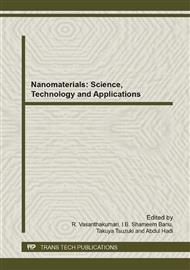p.76
p.85
p.91
p.97
p.103
p.108
p.114
p.118
p.123
Structural and Optical Properties of Nebulized Nickel Oxide Thin Films
Abstract:
Nickel oxide has been widely used as material for antiferromagnetic, electrochromic display and functional layer for chemical sensors. Nickel oxide thin films of various molarities were deposited using a simple nebulizer technique and the substrate temperature was fixed at 350C. The effect of the molarity of precursor solution on structural and optical properties was studied using X-ray diffraction (XRD) and UV-Vis-NIR spectrometer techniques respectively. The band gap of the material was confirmed by photoluminescence spectrometer. It is found that increase in the molarity of 10ml volume of the sprayed solution leads to the increasing in film thickness. X-ray diffraction studies indicated cubic structure and the crystallites are preferentially oriented along (1 1 1) plane. It is also found that as the concentration of the solution increases the transmittance decreases, consequently the band-gap energy wanes from 4.0 eV to 3.2 eV.
Info:
Periodical:
Pages:
103-107
Citation:
Online since:
June 2014
Authors:
Price:
Сopyright:
© 2014 Trans Tech Publications Ltd. All Rights Reserved
Share:
Citation:


